Pipe insulation - types and features
All types of pipelines, regardless of their location, are more or less exposed to the environment. To minimize this effect, pipe insulation is applied. Next, we look at the main types of insulation materials, their properties and applications.
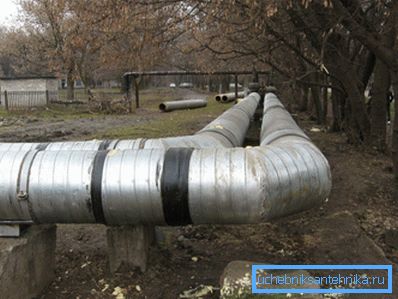
General information
The choice of pipeline shell depends largely on the type of its laying. There are three options for laying:
| Underground in the channels | In this case, the pipeline is most protected from the adverse effects of the environment. The only thing required is the insulation of the heating pipes and the hot water supply system to save the thermal energy of the transported fluid. If the canals are located above the level of soil freezing, then insulation is also required for ordinary water supply. |
| Underground channelless | This implies laying the system directly into the ground. Accordingly, the pipeline needs to be protected from the effects of groundwater, etc. |
| Above ground | In this case, the design is subjected to all atmospheric influences, as a result of which it needs anti-corrosion and, most often, thermal insulation. |
If the coating is chosen incorrectly or is applied in violation of the technology, this can lead to system failure, the need for urgent repairs or even a complete replacement.

Types of insulation
Today, when laying pipelines, the following types of insulation materials are most often used:
- Bitumen;
- Folgoizol;
- Polyurethane shell;
- PU foam shell;
- Glass wool;
- Mineral wool;
- Rubber sheath;
- Polyethylene anti-corrosion insulation.
Now take a closer look at each of them.
Bitumen
Not long ago, the bitumen insulation of steel pipes was the most common. It is a thin layer of polyethylene, which is protected by a bituminous coating. In addition, fiberglass is often used over this coating.
Bituminous waterproofing of pipes is designed to protect the steel surface from corrosion, which can be caused by its contact with the ground and various chemical elements in the ground. Most often in this way cover the tracks, which are laid in sandy, stony or clay soil.
Note! The average operating temperature of the system covered with bitumen should be in the range of -40 - +65 degrees Celsius.
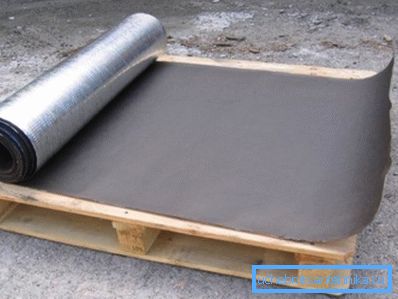
Folgoizol
Folgoizol can also be attributed to bituminous coatings, since it consists of thin aluminum foil and a bituminous-rubber binder.
Among the advantages of this material are the following points:
- Low price that provides profitability.
- Reliability;
- Simplicity and speed of application - the pipes just turn into foloisol web.
Most often, foiled pipe insulation is used for duct and channelless laying of water pipes and heating mains.

Polyurethane shell
This material is a collapsible cylinder, which is put on the pipe, hence the name “shell”.
Among its advantages are:
- Reliability;
- Extremely simple installation instructions;
- Good thermal insulation properties, thanks to which such insulation is most often used for heating pipes and hot water supply;
- Durability;
- Ability to use for both open and underground systems.
For these reasons, polyurethane foam pipe insulation has recently become one of the most common.

PU foam shell
PU foam insulation is applied to the pipes by the manufacturer, i.e. they go on sale already in the shell. In essence, the product is a pipe in a pipe.
The technology of applying this coating is as follows:
- First of all, the surface of steel pipes is processed by means of a blasting unit. This allows to ensure good adhesion of the coating to the steel surface, as it is cleaned from dirt, rust and welding scale.
- Then the pipe is inserted into the shell of polyethylene.
- After that, liquid polyurethane is poured into the space between the inner wall and the outer insulation, which subsequently solidifies.
It must be said that the shell can be not only polyethylene, but also galvanized. Its type depends on the operating conditions of the pipeline. In addition, in the case of laying an open pipeline, the polyethylene jacket must be coated with acrylic or silicone paint, which will protect it from exposure to ultraviolet rays.
Note! The maximum operating temperature in the system where this technical insulation for pipes is used should not exceed 130 degrees Celsius.
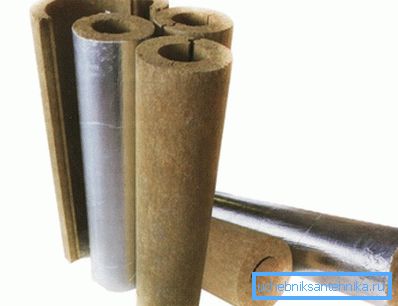
Mineral wool
This material is most often used for thermal insulation of heating systems. As a rule, it consists of mineral wool shells and mats, which can be put on pipes of the most different diameters.
It should be noted that in the case of wetting, mineral wool loses its properties, so it must be waterproofed and protected with galvanized covers. Therefore, in spite of the low cost of the material, it is not the most profitable, especially if it is necessary to insulate a large section of the pipeline.
Tip! Mineral wool is an excellent sound insulation of sewage pipes, especially for plastic risers.
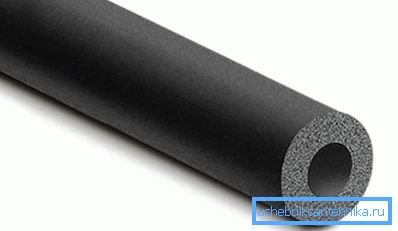
Rubber insulation
Rubber insulation for pipes is used as insulation. Most often it is distributed in the form of empty tubes. For insulation of pipes of large diameters use rubber sheets with an adhesive layer, which wraps the pipeline.
Scope of a rubber cover is quite extensive.
Most often it can be found in the following types of pipelines:
- Pipe ventilation systems;
- Heating network;
- Water supply systems;
- Oil pipelines, etc.
This material is widely used due to the following properties:
- Water vapor tightness;
- Low thermal conductivity;
- Fire safety;
- Elasticity;
- Resistance to all atmospheric influences;
- Easy installation, so you can isolate the pipeline with your own hands.
These properties are due to the wide scope of the material. It must be said that rubber can also be used to soundproof sewer pipes.
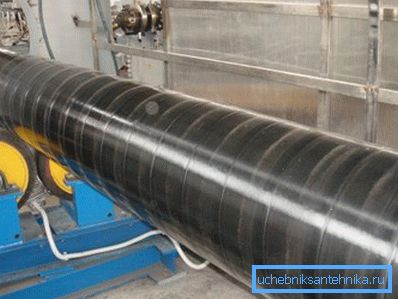
Polyethylene anti-corrosion insulation
Polyethylene anti-corrosion insulation is a combined shell, which consists of several layers. As in the case of PPU, the protection of pipes with this material is carried out in the conditions of production workshops. This is advisable, as it allows to prevent the occurrence of corrosion, in the case of mounting structures in bad weather.
As it is not difficult to guess from the name, this material is designed to protect steel from corrosion. It is used in underground pipelines.
As a rule, polyethylene insulation is used for pipelines of oil pipelines and gas pipelines. For insulation of household level networks, it is more expedient to use a polyurethane foam sheath, or some other material, one of those discussed above.
Here, perhaps, all the main types of insulation, which in our time most often used when laying pipelines.
Conclusion
Today, there is a large selection of different insulating materials for pipelines. This allows you to solve with their help a variety of tasks when laying different types of pipelines. Therefore, pipe insulation is selected in accordance with the requirements set for it in one or another case.
From the video in this article, you can get more information on this topic.